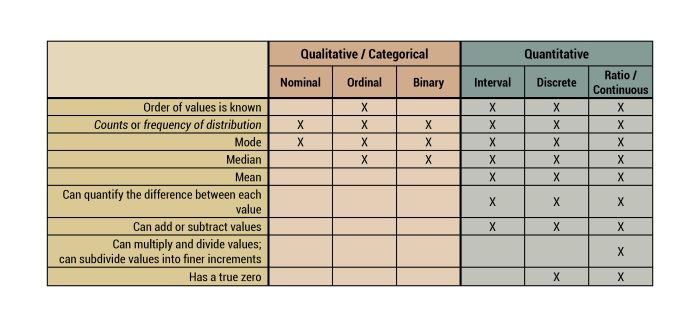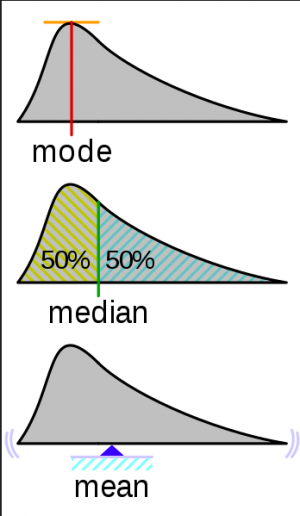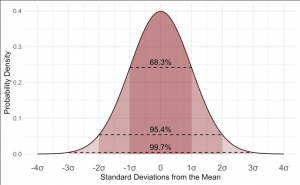Difference between revisions of "Data formats"
| Line 24: | Line 24: | ||
[[File:Likert scale.jpg|thumb|right|Likert Scale]] | [[File:Likert scale.jpg|thumb|right|Likert Scale]] | ||
[[File: Ordinal Data.jpg|thumb|right|Even if one can disagree about the objectivity and purpose of marks, it is a vivid example for ordinal data.]] | [[File: Ordinal Data.jpg|thumb|right|Even if one can disagree about the objectivity and purpose of marks, it is a vivid example for ordinal data.]] | ||
| − | Remember your school grades? A "1" is the best grade in the | + | Remember your school grades? A "1" is the best grade in the German grading system, but is it twice as good than a "2"? Hardly. Such grades are [http://intellspot.com/nominal-vs-ordinal-data/ ordinal numbers]. These are a system of numbers that are ranked in some sense, but the numbers per se do not necessarily reflect a numeric system. In other words, they are highly normative and contested. A "2" might be a good grade for some, and a disaster for others. Ordinal formats are often clearly defined scales that allow people to grade, evaluate or rank certain information. One of the most prominent examples is the [https://www.simplypsychology.org/likert-scale.html Likert scale] that is often used in Psychology. In this case, the scaling is often not reflected in numbers at all, but in levels such as "Strongly Agree" or "Rather Disagree". Such constructed scales may make a true statistician very unhappy, since these scales are hard to analyse, yet there is hardly any alternative since it also does not make any sense to ask: "How happy are you on a scale from 1 to 100?". Therefore, ordinal scales are often relevant in order to create a scaling system that allows for wide comparability or even becomes a norm, such as school grades. My advise would be to [https://sciencing.com/advantages-disadvantages-using-ordinal-measurement-12043783.html use ordinal scales] when this is common practise in this branch of science. Read other studies in the field, and then decide. These are highly constructed scales, hence there needs to be clear reasoning on why you want to use them. |
====Nominal data==== | ====Nominal data==== | ||
Revision as of 09:17, 14 January 2021
Note: The German version of this entry can be found here: Data formats (German).
Contents
Data formats in statistics
The format of your data influences everything else you do further down the road. To paraphrase a proverb, data is in a format, and the format is the data. Therefore, it is essential to know which different data formats exist, and how these may be beneficial, and where you may encounter pitfalls. For more information on different means of measurement, please refer to the 'To Rule And To Measure' entry.
An example of different data formats
Imagine you want to track your diet. Many people do this today, there are diet books and advice everywhere, much information has become available. Now you want to start and become more familiar with what you eat. How would you start? Counting calories? Differentiating between carbs, fat and greens? Maybe you just count every time you ate a Pizza? Or ice cream? Or too much? There are many ways to measure your diet. And these measurement can be in different data formats.
Continuous data
We are all familiar with continuous numbers. Much of our society is ruled by these numbers, and thus much of data analysed in statistics is represented by continuous numbers. Since much of modern measurement is automated within a given predefined system, we often do not have to worry too much how data looks like. Take for instance weight or size. Within Central Europe, this is clearly measured in Grams or Kilograms, and in Centimeters or Meters, respectively. However, if you move to the US, it becomes a whole different story, because of the metric system, or the lack thereof. Suddenly you are some feet tall, and you may weigh some "stones". Many diverse measurement systems exist, and one has to be aware of how these were measured. Take temperature, which I would measure in Celsius. However, my friends from the US are stuck with Fahrenheit, which to me is entirely counter-intuitive. I think the fact that water freezes at 0°C, and boils at 100°C makes Celsius almost divine; however looking at the lowest possible temperature (-273 °C) already showcases that Celsius may not be so divine after all. Hence these systems are constructs, and these constructs build on continuous numbers. Another prominent construct expressed in continuous numbers is the Intelligence Quotient. Being highly questionable from a research standpoint, it serves nevertheless as a basis to identify the elitist Mensa Members. With an IQ of 100, you are considered to be average. Yet, already the expression of what higher and lower numbers mean is widely disagreed upon. This showcases that continuous numbers are widely used to express data, but we have to be aware that this then still represents normative information.
Examples
- the number Pi: 3,14159265359...
- typical weight of a naked mole-rat: 30 grams
- the height of the Empire State Building: 443,2m
- the melting temperature of dark choclate: 45-50°C
Ordinal data
Remember your school grades? A "1" is the best grade in the German grading system, but is it twice as good than a "2"? Hardly. Such grades are ordinal numbers. These are a system of numbers that are ranked in some sense, but the numbers per se do not necessarily reflect a numeric system. In other words, they are highly normative and contested. A "2" might be a good grade for some, and a disaster for others. Ordinal formats are often clearly defined scales that allow people to grade, evaluate or rank certain information. One of the most prominent examples is the Likert scale that is often used in Psychology. In this case, the scaling is often not reflected in numbers at all, but in levels such as "Strongly Agree" or "Rather Disagree". Such constructed scales may make a true statistician very unhappy, since these scales are hard to analyse, yet there is hardly any alternative since it also does not make any sense to ask: "How happy are you on a scale from 1 to 100?". Therefore, ordinal scales are often relevant in order to create a scaling system that allows for wide comparability or even becomes a norm, such as school grades. My advise would be to use ordinal scales when this is common practise in this branch of science. Read other studies in the field, and then decide. These are highly constructed scales, hence there needs to be clear reasoning on why you want to use them.
Nominal data
Whenever you have ordinal data that represents levels that cannot be ranked, it is called nominal data. An example would be different ethnicities, of different types of gender. This already highlights, that we are here confronted by often completely different worldviews, thus nominal data represents a stark case of a normative view of the world. Gender is a prominent example, since some people still define gender by a biological stereotype (Female/Male), which according to my worldview is clearly wrong. Nominal data formats hence demand an even clearer reflection than ordinal data, where at least you may say that a certain school grade is higher than another one. This is not the case for nominal data. Therefore, one has to be extra careful about the implications, that a specific constructed scale may imply.
Categorical data
Categorical data can consist of many different factors. These factors are not ranked, but instead independent from each other. Such categories are typically constructed, and thus contain information that is deeply normative or designed. An example would be hair color, which can be in human perceptions of colours, yet is often also described with different names when it comes to professional hair products. Within statistics, categories are often designed so that within a scientific experiment, categories are constructed in a sense that allows for a meaningful testing of the hypothesis, and meaningful is then in the eye of the beholder. Different levels of fertiliser would be such an example, and the categories would often be build around previous knowledge or pre-tests. Categories are thus of particular importance when it comes to the reduction of the complexity of the world, as it would not be possible to test all sorts of different levels of fertiliser in an experiment. Nevertheless, this demands a clear recognition that categories are then constructed, and deeply normative.
Binary data
The most reduced data format is binary data, which basically consists of two levels. In computer science this may be a simple 0 and 1, but the great breakthrough of that dataset was early on in the insurance business as well as in medicine, where dead or alive are often the most fundamental questions. Binary information is clearly simplistic, but quite often this matches with a certain view of reality. Take the example of being able to play an instrument. If somebody asks you whether you can play the piano, you will probably say yes or no. You may most likely not qualify your answer by saying "I play better than a monkey, but worse than Horowitz". Some modest folks may say "I can play a bit", or "I am not very good", or "I used to be better", but very often people answer yes or no. Hence binary data allows for a simple view of reality, and this may often match with the world how we perceive it. But be aware: Other people may have a less simple view.
Choosing the right data format
You may wonder now how to choose the right data format. The answer to that is quite simple. Any data format should be as simple as possible, and as complex as necessary. Follow Occam's razor, and you will be fine. Of course this sounds appealing, but how to know what is too simple, and what is too complex. Here, I suggest you build on the available literature. Read other publications that examined a certain phenomenon before, these papers may guide you in choosing the right scale.
Overview about characteristics of some data formats
A word on indices in statistics
In economics and finance, an index is a statistical measure of change in a representative group of individual data points. A good example of the application of an index that most people know is the GDP, the gross domestic product of a country. I largely been criticised for being too generalised and not offering enough nuance to understand the complexity of the single country, many social, economical and other indicators are correlated with the GDP.
In ecology, a prominent example for an index is the so-called Shannon Wiener index, which represents abundance corrected diversity measures. A prominent example from economy again is the Dow Jones index while the human development index tries to integrate information about life expectancy education and income in order to get a general understanding about several components that characterise countries. The GINI coefficient tries to measure inequality, as surely daring endeavour, but nevertheless quite important. In psychology the intelligence quotient, which is of course heavily criticised, is a known example of reducing many complex tests into one overall number. In the face and quotients are hence constructs that are often based on many variables and try to reduce the complexity of these diverse indicators into one set of numbers.
Descriptive statistics
Descriptive stats are what most people think stats are all about. Many people believe that the simple observation of more or less, or the mere calculation of an average value is what statistics are all about. The median often shows us such descriptive statistics in whimsical bar plots or even pie charts. Hence many numbers can be compiled into descriptive statistics, which can help to gain an overview about simple understanding of more complex numbers. The emphasis is however, that this is not an analysis. Instead such a compilation of data can only aid some overview. In order to be versatile in this type of descriptive statistics, it is important to know some basics.
Mean
The mean is the average of numbers you can simply calculated by adding up all the numbers and then divide them by how many numbers there are in total.
Median
The medium is the middle number in assorted set of numbers. It can be substantially different from the mean value for instance, when you have large gaps or cover wide ranges within your data. Therefore, it is more robust against outliers.
Mode
The mode is the value that appears most often. It can be helpful in large datasets are when you have a lot of repetitions within the dataset.
Range
The range is simply the difference between the lowest and the highest value and consequently it can also be calculated like this.
Standard deviation
The standard deviation is calculated as the square root of variance by determining the variation between each data point relative to the mean. It is a measure of how spread out your numbers are. If the data points are further from the mean, there is a higher deviation within the data set. The higher the standard deviation, the more spread out the data.
#descriptive statistics using the Swiss dataset
swiss
swiss_data<-swiss
#we are choosing the column fertility for this example
#let's begin with calculating the mean
mean(swiss_data$Fertility)
#median
median(swiss_data$Fertility)
#range
range(swiss_data$Fertility)
#standard deviation
sd(swiss_data$Fertility)
#summary - includes minimum, maximum, mean, median, 1st & 3rd Quartile
summary(swiss_data$Fertility)
Back of the envelope statistics
Back of the envelope calculations are rough estimates that are made on the small piece of paper, hence the name. These are extremely helpful to get a quick estimate about the basic numbers for a given formula of principle, thus enable us to get her quick calculation with either the goal to check for the plausibility of the assumption, or to derive a simple explanation of the more complex issue. Back of the envelope calculations can be for instance helpful when you want to get a rough estimate about an idea that can be expressed in numbers. Prominent examples for back of the envelope calculations include the dominant character coding of the World Wide Web and the development of the laser. Back of the envelope calculations are fantastic within sustainability science, I think, because they can help us to illustrate complex issues in a more simple form, and they can serve as her guideline for a quick planning. Therefore, they can be used within other more complex forms of methodological applications, such as scenario planning. By quickly calculating different scenarios we can for instance make her plausibility check and focus our approaches on-the-fly. I encourage you to learn back of the envelope calculations in your everyday life, as many of us already do. I learned to love "Tydlig", which is one of the best apps I ever used, but unfortunately I only know her version for my Apple devices. It can however be quite helpful to break numbers down into overall estimates, as the video below illustrates.
External links
Videos
Intelligence Quotient: Answering the question if the IQ really measures how smart you are
Different data formats: An overview
Binary data: How our computer works
The Shannon Wiener index: An example from ecology
The Dow Jones Index: An example from economy
The Intelligence Quotient: A critical reflection
Descriptive Statistics: A whole video series about descriptive statistics from the Khan academy
Standard Deviation: A brief explanation
Mode, Median, Mean, Range & Standard Deviation: A good summary
Back-of-envelope office space conundrum: A real life example
Articles
Measurement: Reflecting upon different measurement systems across the globe
IQ: An explanation
Nominal vs. ordinal data: A comparison
Likert scale: The most popular rating scale
Ordinal data: Limitations
Nominal data: An explanation
Binary data: An explanation
GDP: A detailed article
The Human Development Index: An alternative to the GDP
The GINI index: A measure of inequality
Descriptive Statistics: An introduction
Descriptive Statistics: A detailed summary
Back of the Envelope Calculation: An explanation
Estimates of Next Quarter’s Unemployment Rate: An Example For Back of the Envelope Statistics
The author of this entry is Henrik von Wehrden.











